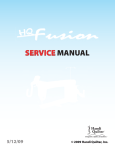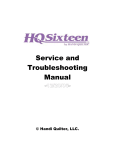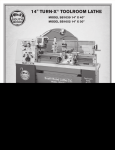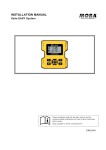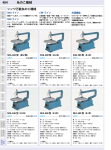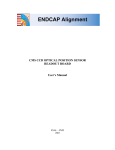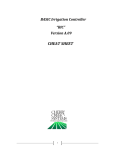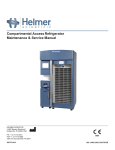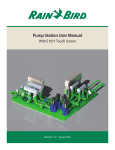Download HQ Sweet Sixteen Service Manual.indd
Transcript
SERVICE MANUAL Designed by a Quilter, for Quilters.® 12/20/10 © 2010 Handi Quilter, Inc. Table of Contents Page About the HQ Sweet Sixteen About the Manual Service Manual General Rules General Specifications Assembly Torque Specifications Lubrication Specifications Section 0 Lubrication Instructions 1 General Observation of Front Frame Cover, Mast and Hand Wheel 2 Removal of Front Cover 3 Securing Flats and Screws 4 Axial Play Check and Adjustment 5 Adjusting the Base Plate 6 Adjusting the Motor Drive/Timing Belt Tension 7 Adjusting the Presser Bar Height/Presser Foot 8 Needle Position, Check, & Adjustment 9 Adjustment of the Loop Lift and Needle Distance 10 Adjusting Needle Height 11 Adjustment of the Stop-Finger 12 Adjusting the Needle Height with Cylinder Tool 13 Electronic Adjustments and Indicators Indications of Speed/Needle Position Sensor Indications of Speed/Needle Position Sensor Failure LED Identification Control-Pod Power LEDs Display Communications LEDs Fuses 3 3 3 4 5 6 7-8 9-11 12-18 19-20 21 22 23 24-25 26-27 28-31 32-33 34 35-36 37-40 37 38 39 39 40 40 A digital copy (pdf) of this manual is available online on the Rep website. Go to www.HandiQuilter.com and click on Rep Login, then use the username and password provided to you to obtain access to the Rep website. About the HQ Sweet Sixteen The HQ Sweet Sixteen utilizes high-tech electronics and an innovative touch-pad user interface to offer greater functionality and ease of operation to home quilters than ever before conceived in the quilting industry. The HQ Sweet Sixteen quilting machine is a high quality machine that incorporates very robust design features and is very easy to service. the construction of a house. Walls cannot be erected until the foundation is in place. Similarly, this service manual has been written with an adjustment logic that is driven by the construction processes used to create the machine. If the service technician carefully follows the adjustment steps in the order presented, a fine running quilting machine is possible each and every time. The HQ Sweet Sixteen machine is constructed following a specific sequence of operations, similar to About the Manual and HQ Support The purpose of this service manual is to help the technician complete a repair on a machine accurately and quickly. The manual is complete with photographs and explanations that we hope will aid you in your repair efforts. In addition to the teaching aids found herein, you will also find all of the tools listed that are necessary for adjustments. If you need help in locating these tools for purchase, please contact Handi Quilter. Handi Quilter’s Customer Relations technical staff is available for assistance and advice during normal business hours. For additional help in technical training, we refer you to the training schedule at the Corporate Office in North Salt Lake, Utah which is available on the Rep website or by calling the HQ Rep Support Line at 1-866-262-1680. A digital copy (pdf) of this manual is available online on the Rep website. Go to www.HandiQuilter.com and click on Rep Login, then use the username and password provided to you to obtain access to the Rep website. Service Manual General Rules • Adjustments shown in the manual should only be made if a setting deviates from the tolerance specified in the manual. • Adjustments should be made only in the logical sequence shown and described in the manual. (Do not jump ahead or start in the middle of the adjustment sequence – this may cause additional or more serious problems than the original issue.) • Safety must be considered when working on any machine. Safety warnings are included throughout this manual where appropriate, but these warnings do not address all possible safety concerns that might confront the service technician. HandiQuilter.com • When working on or near any live electrical assemblies, the power cable must be removed from the machine. • We urge you to observe the cautions in the manual. • Please note that the hand wheel must always be turned in the direction of normal rotation unless otherwise instructed. This is especially true when making the loop-lift timing and needle-height adjustment. (Exceptions are removing thread locks or testing belt tension. The hand wheel may be rocked forward and reverse in these cases.) Page 3 General Specifications Throat Dimensions: (210 mm X 406 mm) 8.25” X 16” Quilting Speed: Min 75spm, Max 1500spm Needle System: 134 (135 X 7) Needle Sizes, (recommended): 12/80 - 20/125 Hook System: Rotary, Vertical, M-class bobbin Bobbin Type: Aluminum, Class M Bobbin Case: Type MF Motor Type: Brushless DC Needle Positioning: Up and down, walking stitch Electrical Power: 90 – 264 VAC, 47-63Hz, 300W peak LED Power Consumption: 2.25 W Hopping Foot Stroke/Lift: 5 mm Needle Bar Stroke: 35.3 mm Take-Up Stroke: 73 mm Lubrication, main components: Kluber Lube, permanent Lubrication of hook: Velocite 10, Texaco 22 Page 4 HQ Sweet Sixteen Service Manual Assembly Torque Specifications The Torque Specifications apply to all internal and external fasteners in sizes 4.0, 5.0 and 6.0 mm in general at ISO 4762 Screw class 8.8. The torque specifications are also generally classified as soft-jointed and are listed according to size and placement in the machine. 1. 4 mm Allen socket head cap screws, Class 8.8 @ 2.5 Nm (Uses 3 mm Allen tool) • Head-frame, bearing retainers, front cover small 2. 4 mm Allen set screw, class 8.8 @ 1.2 Nm (Uses 2.0 mm Allen tool) • Tension assembly, three-hole thread guide, motor pulley, hook 3. 5 mm Allen socket head cap screw class 8.8@ 5.6 Nm (Uses 4 mm Allen tool) • Front cover large • Belt tensioner • Drive-train bracket 4. 5 mm Allen set screw, Class 8.8 @ 2.4 Nm (Uses 2.5 mm Allen tool) • Main-shaft timing pulley, hook-shaft timing pulley, collar 5. 6 mm Allen socket-head cap screws Class 8.8 @ 9.9 Nm. (Uses 5 mm Allen tool) An exception must be observed here since the screws are considered soft-jointed and shallow-threaded and are used externally. It is therefore advised that this torque specification not exceed 6 Nm. • Base plates 6. 6 mm Allen set screw, Class 8.8@ 4.5 Nm (Uses a 3 mm Allen tool) • Hand wheel HandiQuilter.com Page 5 HQ Lubrication Specifications Rep Lube Kit Part# QM49262 Lubricant Type #1. Kluber, Constant OY68 (Red) #2 Kluber, Mikrozella G 8 OY (Blue) #3. Kluber, GLY 2100 (Yellow) #4. Kluber, NCA 15, Isoflex (Green) #5. Kluber, GLY 151, Polylub (Orange) #6. Conoco, Hydroclear R&O 32 (Purple) or similar white oil, i.e. Texaco 22, or Velocite 10 Machine Components All main bearings Main bearing reservoirs Take-up lever, articulating link and needle bar driver Take-up caged needle bearings Presser bar guide and plunger, lifting link and Pitman eccentric Hook race HQ Lubricant Order Numbers #1 Red OY 68 #2 Blue Mikrozella G 8 OY #3 Yellow GLY 2100 #4 Green IsoFlex NCA-15 #5 Orange GLY 151 #6 Purple Texaco 22, hook race only All the above in box w/ booklet Replacement Lube Replacement Lube Replacement Lube Replacement Lube Replacement Lube Replacement Lube Rep Lube Kit Box #1 Red: QM49301 #2 Blue: QM49302 #3 Yellow: QM49303 #4 Green: QM49304 #5 Orange: QM49305 #6 Purple: QM49306 #1-#6 Kit QM49262 HQ Lubricating Schedule The HQ Sweet Sixteen lubricating schedule should be followed every year up to every two years to ensure top mechanical performance. Page 6 HQ Sweet Sixteen Service Manual HQ Sweet Sixteen Lubrication Lube #1 (Red), between the bearing and the shaft and Lube #2 (Blue) between bearing OD and the bearing support at 6 places shown. Apply one drop of Lube #6 (Purple), to the raceway of the bobbin case support two to three times per day. This application is based upon sewing for 8 hours of machine time (or approximately every other bobbin change). If the machine is used less, lubricate the hook less frequently. After the lubrication of the hook, it is recommended that one momentarily sew on scrap material before resuming the sewing of the quilt. Failure to do so may result in oil stains on the quilt. HandiQuilter.com Page 7 HQ Sweet Sixteen Lubrication - Continued 1 1 #1 (Red) OY 68 One drop on the side of the needle and presser bars. (4 places) 5 3 (orifice located a little behind the top radius.) 3 4 5 5 4 3 5 1 Page 8 #3 (Yellow) GLY 2100 One drop per orifice, articulating link, take-up lever and needle bar driver (3 places) #4 (Green) IsoFlex NCA-15 Inside caged needle bearings (2 places) #5 (Orange) GLY 151 Add grease sparingly to the presser-bar slide and plunger. Add a small amount between the stylus and cams of both the presser-bar lifting link and the hopping-mechanism lifting arm. (4 places) 1 HQ Sweet Sixteen Service Manual 1. General Observation of the Front Frame Cover, Mast and Hand Wheel The following observations, accompanied by necessary adjustments, will ensure trouble-free thread passage. Failure at any of these points will significantly affect thread tension. Check: 1. The thread mast should be adjusted so that the eyelet loops are centered directly over the spool pins. (Figures 1.1 a & 1.1 b) Figure 1.1 a If a correction is necessary: Loosen the jam nut, reposition and tighten the jam nut. (10 mm open end wrench) Check: 2. Make sure that a gap of 1.0 mm to 1.5 mm exists between the frame and the hand wheel. (Note: The hand wheel screw is inside the front cover and cannot be seen from the outside of the machine, therefore it can only be adjusted with the front cover removed.) (Figure 1.2) Figure 1.1 b If a correction is necessary: (Usually this would only be necessary if the hand wheel is rubbing, has an extreme gap or is loose.) Remove the front cover (see Section 2), loosen the hand-wheel set screw, position the hand wheel and re-tighten the set screw. (3 mm handle Allen) Figure 1.2 HandiQuilter.com Page 9 1. General Observation - Continued 1 2 3 5 4 6 7 Figure 1.3 B 3. Check/Inspect: Test the condition of the thread guides 1, 2, 3, 4, thread stirrup 5, thread guide 6 and needle bar thread guide 7 for any abrasions, cuts, or electroplating blistering. Test each guide by flossing it with thread, left to right and front to back in all directions, checking for any sharp defects that may damage or cut the thread. Replace any damaged parts. (Figure 1.3) (2 mm and 2.5 mm handle Allen) Check the top tension assembly for the following: Check between the tension discs for any foreign material that could prevent the discs from functioning properly. If a correction is necessary: Check the relative location of the knob before removing the knob. Remove the knob, detent washer, tension discs and cone spring. (See Figures 1.5 through 1.10.) Clear and reassemble. Note: On very rare occasions, if the machine has been used an extreme amount, it is possible for a groove to be worn into the tension discs. This will make it impossible for the tension to be adjusted correctly as the thread can pass through this worn groove in the tension discs, while the unworn part of the discs touch, resulting in no tension on the thread in the groove. This may result in thread nests on the bottom of the quilt. The top tension assembly will need to be replaced in this instance. Top tension assembly part #QM10198. Check: That the take-up spring has a normal torsion tension and inspect the spring for any cuts, breaks or abrasions. When moved by hand and released, it should return to the end of the cutout in the top tension assembly. If a correction is necessary: (2 mm handle Allen, #1 flat screwdriver) (Figure 1.5) A Please Note: Tension knob may be either gray or black in color. Figure 1.4 Figure 1.5. Top tension assembly, fully assembled (two views) Page 10 HQ Sweet Sixteen Service Manual 1. General Observation - Continued Figure 1.6. Knob removed Figure 1.7 Detent washer and cone spring removed Figure 1.8 .Tension discs removed (two views) Loosen the set screw under the top tension assembly a couple turns as it fixed into an undercut into the top tension base. (Screw A, Figure 1.4 on previous page.) Note that the set screw is on about a 30° angle to the machine front cover. Loosen the slotted set screw at the rear of the top tension base and rotate the split bolt until the spring returns to the end of the slotted groove when pushed and released. Re-tighten the set screw firmly. If the take-up spring needs replacing, remove the tension parts and split bolt and carefully work the spring around until it can be removed. Replace with a new take-up spring (Part #QM10197). Make sure the split bolt is inserted all the way into the base and retighten the slotted screw. Adjust the take-up spring tension so that it barely returns to the end of its slot when pressed to the side and released. Figure 1.8 shows this position. NOTE: Too much spring tension will affect the stitch quality. Reinstall the top tension parts on the split bolt and then the assembly into the machine front cover and tighten the set screw. Radial postion: When the top tension assembly is properly installed into the machine front cover, the straight part of the take-up spring (before the loop) will be straight up at 12 o’clock (or a little bit towards 11 o’clock). (Figure 1.4, Position B on previous page.) Figure 1.9. Fully disassembled, laid out in order of assembly Check that the top tension knob is not too loose on the split bolt and that it has some resistance so that it will not vibrate loose while sewing. If a correction is necessary: To correct: remove the knob, detent washer and cone spring, adjust the split bolt by spreading with a flat screwdriver until the knob has adequate resistance to keep its setting. Caution: The split bolt is hardened and if adjusted too much it may break. The top tension assembly will then needs to be replaced. (Top Tension Assembly Part #QM10198) Figure 1.10. Tension assembly split bolt HandiQuilter.com Page 11 2. Removal of the Front Cover A Tools Required: 2 mm, 3 mm, 4 mm handle Allen, 4 mm L Allen, #3 flat screwdriver and #2 Phillips screwdriver. 1. Loosen set screw on top of cover (position A in Figure 2.1). Rotate the 3-hole thread guide to allow access to the frame screw (Figure 2.2), then re-snug the screw so the guide will not become misplaced. (2 mm handle Allen tool) 2. Remove the three frame screws circled in Figure 2.3 (3 mm handle Allen) Figure 2.1 A 3. Before removing the C-pod, use a grounding mat and wrist strap. Connect the two ground clips to the bare threads of the hopping foot. (Figure 2.4) Caution: Make sure the machine is unplugged from the wall before removing the C-pod or whenever working on the machine. 4. Remove the “C-pod” by unscrewing the 4 screws. (Figure 2.5) (#2 Philips screwdriver) Figure 2.2 5. With the machine properly grounded to a grounding mat, and with a ground wrist strap (Figure 2.4), carefully unplug the cables from the C-pod. Be careful not to touch the circuit board or damage the cables or plugs. They should be pulled straight out by the connector housing. (Page 13, Figures 2.6-2.8) Note: The plugs are labeled and keyed on the C-pod circuit board. See Figures 2.6- 2.13 for reconnection information. (Continue to Step 6 on page 14.) Figure 2.3 Figure 2.4 Page 12 Figure 2.5 HQ Sweet Sixteen Service Manual A B C D E Figure 2.6 C-Pod Circuit Board Identification (Detail) A: Encoder connection. B: Motor driver connection. C: Display Connector F A B J14 J15 G J16 C Motor D E F Figure 2.8 C-Pod cables (A-F) shown disconnected G: Lighting connection for light ring Figure 2.7 C-Pod Cable and Circuit Board Identification D: Left cable, red and yellow, position labeled J14 on board. E: Center cable, black and yellow, position labeled J15 on board. F: Right cable, red and black, position labeled both J16 and Motor on board. HandiQuilter.com Page 13 2. Removal of the Front Cover Continued 6. To remove power supply, loosen the 3 screws on the right side and remove the 3 screws on the left side (shown circled in orange in Figure 2.9). Slide the power supply to the left and unplug the bottom cable. (Figures 2.9-2.11) Figure 2.9 Important Note: Insulator material must cover all metal on the back of the power supply for proper insulating purposes. (See position A in Figure 2.10.) (Continue to Step 7 on page 18.) A Figure 2.10 Page 14 Figure 2.11 HQ Sweet Sixteen Service Manual Internal Wiring Reference Photos F B G Figure 2.12 Cable Identification F: Motor driver board with motor power (top) B: Motor driver (center) G: Motor (bottom) Figure 2.13 Location of encoder disc and sensor (circled) HandiQuilter.com Page 15 P-pod Cable Reference Photos Figure 2.14 Figure 2.17 Important note: Two ground wires are fixed with a socket head cap screw and star washer (shown circled in Figure 2.15) for safety grounding. Figure 2.15 Important note: Insulator material must cover all metal on the back of the power supply for proper insulating purposes (see circled area in Figure 2.16). Page 16 Figure 2.16 HQ Sweet Sixteen Service Manual C-Pod and Cables P-Pod and Cables J14 Power J15 Power J16 Motor J8 Encoder J13 Motor Driver J11 Display J12 Display Figure 2.18 Inside View of C-Pod Figure 2.19 Inside View of P-Pod DC Power Connections (at top of photo): Left, red and yellow cable and connector (labeled J14). Center, black and yellow (labled J15). Right, red and black (labeled Motor). The two bottom white connectors (at lower left in photo) are for AC power out of P-pod to the two power supplies. One power supply is mounted to the back frame and the second power supply is mounted to the front frame. The cables that connect to these connectors each have three black wires. Control Board Connections (left center): Encoder, Motor Driver, Display Connections. CAUTION! DANGER OF ELECTRICAL SHOCK! DANGEROUS VOLTAGES. CAUTION! Do not plug in main power or run the quilting machine with the P-pod taken off of the machine and/or open so that any human body part could come in contact with electrical energy. Note 2: The plugs are labeled and keyed on the Cpod circuit board. Note 3: After installing the cables through the service hole on the front cover (see Figure 2.7), carefully Note 1: The C-Pod and the P-Pod are STATIC SENSI- push the excess cable back into the machine as there TIVE parts and should not be handled without special is no room in the pod for extra cable. The cables are to the right of the drive-train bracket and therefore discharge tools. For this reason, all C and P Prints protected from moving parts on the left side. will be exchanged in the pod covers. Do not remove the Printed Circuit Boards (PCBs) from the pods. HandiQuilter.com Page 17 2. Removal of the Front Cover Continued 7. Remove the needle plate. (Figure 2.20) (#3 flat screwdriver) Figure 2.20 8. Loosen both the front and rear base plates a couple turns to allow the front cover to be removed. (Figures 2.21 and 2.22) (Tools needed: 5 mm handle Allen wrench) 9. Remove the 5 frame screws shown circled in Figure 2.23. Note: The fifth screw is behind the C-pod and was removed in step 4. (4 mm handle Allen. May need 4 mm L Allen tool to break screws loose.) Note: The three small screws (shown circled in Figure 2.24) were removed in step 2. 10. Separate the front frame cover. Make sure the take-up lever does not get caught in the frame slot. Figure 2.21 Important Note: The take-up lever is very hard and will break, not bend. Figure 2.22 Figure 2.23 Page 18 Figure 2.24 HQ Sweet Sixteen Service Manual 3. Checking and Securing Flats and Screws The HQ Sweet Sixteen has been designed using flats and special screws to help prevent loop lift timing from slipping, except at the hook. (If the hook cannot slip then something has to break when something goes wrong. The hook is designed to be adjusted without removing the front cover.) First check the torque specifications chart on page 5, then Thrust Collar on Slanted Flat check the following locations, making sure that the first screw of a timed component has been fixed firmly on the respective flat on the shaft: Pitman Crank 1st screw Take-up Lever Driving Link 1st screw Figure 3.1 1. The Pitman crank (Figure 3.1) (# 5 slotted screwdriver) 2. The take-up lever driving link, (Figure 3.1) (3 mm handle Allen) 3. The main shaft timing pulley (Figure 3.2) (2.5 mm handle Allen) 4. The hook-shaft timing pulley (Figure 3.4 on page 20) (2.5 mm handle Allen). 5. Trust collar on slanted flat. Note: The screws are generally positioned 120 degrees apart. When the first screw (Position 1) has been located and tightened on a flat, the second screw is then tightened, compounding the tightness of the first screw, thus securing and assuring that timing will not change. Note: The thrust collar flat is inclined. The left screw will tighten onto the inclined flat. The collar is a wide collar with two in-line screws. The fine finish of the collar goes against the thrust washer and bearing. The left screw closest to the bearing is provisionally tightened and the right screw is then fully tightened. Finally the left screw is fully tightened. Check to make sure the main shaft has minimal to no play and that the collar tightening procedure did not create a tight main shaft condition. If so, readjust the collar again. 1st screw Main Shaft Timing Pulley on flat Flat Figure 3.3 HandiQuilter.com Page 19 3. Checking and Securing Flats and Screws - Continued Position 1 120 o Position 2 Direction of rotation First Screw, First Position Rule The first screw or first position is ALWAYS located 120° apart in the direction of rotation from the second screw or second position. The first screw in direction of rotation goes on the flat. (Figure 3.3) Note: First screw in direction of motion goes on the flat. The first screw is 120º before the 2nd screw. The 2nd screw is then 240 degrees before the 1st screw. Figure 3.3 Hook-shaft timing pulley Tools needed: (2.5 mm handle Allen) Note: The hook-shaft timing pulley rotates the opposite direction as the main shaft timing pulley. Carefully note the labeled first screw (Figure 3.4). Note: The hook-shaft collar does not have a flat. The flat is located on the hook-shaft timing pulley 1st screw. Hook-shaft Timing Pulley 1st Screw Figure 3.4 Important Hook-Shaft Notes The hook-shaft turns two times per stitch and rotates in the opposite direction from the main shaft. Please carefully note which screw is the first screw in the direction of motion and on the flat. The hook-shaft pulley is set to a specific setting from the end of the shaft to allow proper needle-to-hook distance adjustment. Adjust the collar to remove axial play, not the hook-shaft pulley, or the setting can be thrown off, which may make it so needle-to-hook distance cannot be adjusted. The HQ Sweet Sixteen utilizes long collars with two screws in line to help prevent the collar from tipping when tightened, causing variation of tightness or play, as the collar rotates 360º. To ensure that there is no tightness or play, the collar should be checked through a full rotation until it has minimal tightness and minimal play. Page 20 HQ Sweet Sixteen Service Manual 4. Axial Play Check and Adjustment Axial or end play on shafting can result in noise, wear and faulty sewing. Check: 1. Check the main-shaft by pushing and pulling on the hand wheel. (Figure 4.1) Note: A small amount of main shaft axial play is permissible. Too much main shaft play, however, may cause noise and or stitching issues. If a correction is necessary: • Remove the front cover. • Loosen the collar screws (2.5 mm handle Allen) (Figure 4.2). • Adjust so that minimal to no play is detected. • Provisionally set the screws. • Check that the shaft has minimal play and no tightness from the collar being too tight by rotating the shaft through a few 360o rotations. • Fully tighten the screws. • Check shaft again for play or tightness. Figure 4.1 2. Check the hook shaft by pushing and pulling the hook as shown in (Figure 4.3). Remove play here Test left to right Figure 4.2 If a correction is necessary: • Remove the front cover. • Remove the play by loosening the hook-shaft thrust collar (not the hook-shaft timing pulley) and adjusting out any axial play (Figure 4.4). Note: There is no flat for the hook-shaft thrust collar. • Check for proper setting by rotating shaft through a few 360o rotations. Collar set screws Figure 4.3 Take out play here Figure 4.4 HandiQuilter.com Page 21 5. Adjusting the Base-Plate Feet Tools required: (5 mm handle Allen) Check: 1. The base plate must be adjusted so that the rubber feet will sit flat on a planed surface. Note: This is done on a precision surface plate at the factory during assembly. If a correction is necessary: Thin shim washers may be used as shown in (Figures 5.1 and 5.2). Figure 5.1 Figure 5.2 Page 22 HQ Sweet Sixteen Service Manual 6. Adjusting the Motor Drive/Timing Belt Tension The HQ Sweet Sixteen machine utilizes a single motor drive/timing belt system. Tools required: 4 mm handle Allen Check: With the machine front cover removed, check the belt tension for tautness by pressing it with the index finger (Figures 6.1–6.2). Press the vertical center of the belt with approximately 2 lbs of pressure. The belt should deflect about ½”. Proper belt tension provides for some belt flexibility under light finger pressure, but should not be so tight as to bind the machine. Double-check the tension by rotating and rocking the hand wheel. Confirm that there is no backlash or play between the belt teeth and any of the driven components. Confirm also that there is an immediate transfer of motion to all components driven by the belt. Figure 6.1 Important: Do not over-tighten the belt as this will make the machine too tight and difficult to turn and may cause other undesirable issues. If a correction is necessary: • Insert a 4 mm handle Allen tool through the hole in the main frame casting (Figure 6.2). Loosen the socket-head belt tensioner screw. Adjust the belt tensioner by pressing down on the tensioner and while holding down on the tensioner re-tightening the belt tensioner screw (Figure 6.2). • Note: This adjustment can only be made with the front cover off so the tensioner can be pressed down to set proper belt tension. Important: Do not attempt to set with the front cover on as improper belt tension will result. Figure 6.2 Important Note: Ensure that the special washer with step is down into the tensioner bracket slot and flat, not tilted, when tightened, so the tensioner will not slip, resulting in a loose belt (Figures 6.3-6.6). Figure 6.4 Figure 6.3 HandiQuilter.com Figure 6.5 Ensure that the special washer is flat and in slot. See Figures 6.4, 6.5, 6.6. Figure 6.6 Page 23 7. Adjusting the Presser Bar Height Tools required: 3 mm handle Allen, 0. 5 mm feeler gauge, 8 mm open end wrench Check: When the needle bar is in its lowest position, the sewing foot should be no higher than 0.5 mm above the needle plate as shown in Figure 7.3. It is permissible for the hopping foot ring to lightly touch the needle plate. Figure 7.3 Screw “C” access hole Figure 7.4 Screw “C” Note: The factory default is for the presser bar (not the jam nut) to be about 1.5” above the needle plate with the needle in the lowest position. In this position the foot should be screwed into the presser bar about 10 or 12 revolutions. Check the foot without removing it by looking to see that there are about 12 threads of the foot exposed below the hopping foot jam nut. It is important to check this before resetting the presser bar height in case the end user has changed the foot height. Improper setting of the presser bar height and foot height can cause stitch problems, including skipped stitches. If a correction is necessary: • Turn the hand wheel until the needle bar is at its lowest position. • Place the (0.5 mm feeler gauge Part # QM40133) under the hopping foot with the machined edge up (Figure 7.3). • Loosen screw C through the machine front cover (3 mm Allen driver) (Figures 7.4, 7.5) • Wiggle the presser bar up or down to the desired position. Tighten screw C by pushing down lightly on the tool blade towards the table while tightening. This will ensure that the hopping-block mechanism contacts the appropriate lifting lever and eccentric. • Confirm the ring of the foot is centered on the needle when the screw is re-tightened. Figure 7.5 Shown with front cover off Page 24 HQ Sweet Sixteen Service Manual 7. Adjusting the Presser Bar Height - Continued Adjusting the Hopping Foot The HQ Sweet Sixteen features the “KinetiQuilt” hopping mechanism, allowing the hopping foot to move (hop) up, down and dwell on the fabric when the needle is in the fabric. This allows fabric to move through the machine similar to a normal sewing machine with a feed dog. The dwell time allows for a longer hesitation of the hopping foot on the fabric and completion of the stitch cycle. The results are better tension, less needle breakage and increased hook life. Figure 7.6 The hopping foot should be no more than 0.5 mm above the needle plate when the needle is in the lowest position. It is permissible for the hopping foot to touch the needle plate. The end user may have adjusted the hopping foot at the threads. This usually can be corrected as stated below. If a correction is necessary: • Hold the hopping foot, loosen the jam nut, screw the hopping foot shaft to the desired height. Make sure the ring is centered on the needle, Tighten the jam nut. (8 mm open end wrench) • Note: Make sure you hold the hopping foot while tightening and loosening the jam nut as shown (Figure 7.6). • Warning: if the jam nut is not properly tightend the hopping foot may become loose and be hit by the needle causing serious machine problems. HandiQuilter.com Page 25 8. Needle Position, Check, & Adjustment The needle position adjustment is the most important of all adjustments in the machine. Needle position provides the foundation for which all other settings are made. Once the needle position has been completed, great care must be maintained to keep this setting. It is important that the sewing machine be transported carefully, to avoid bumping or dropping. Bobbin case end Figure 8.1 (Note: X & Y marks for clarification) A B Check: Use a new System 134/Size 100 needle. Check the needle for straightness on a flat surface such as the needle plate. The needle must be centered in the stitch hole of the needle plate as shown in Figure 8.1. (2 mm and 3 mm handle Allen). Check with needle eye flush with the needle plate, do not check with needle in the lowest postions. Add ( screw to screw) after adjustment for Y axis (screw to screw): This adjustment is done with the cover off. Adjustment for Y axis: Cover Off Note that adjustment is done with the front frame cover off. If a correction is necessary: • Loosen first screws D and G (Figure 8.2) • Loosen screw A and screw B (Figure 8.2) G • While pushing the head frame back into the main casting, gently slide the head frame left or right to correct as necessary. D • Tighten screws A and B in Figure 8.2. • Note: If needle position changes, repeat the process. Do not tighten screws D or G at this time. Figure 8.2 Page 26 HQ Sweet Sixteen Service Manual 8. Needle Position, Check, & Adjustment - Continued Adjustment for X axis: Cover On (see page 14 for wire connections) F C G Important Note: The picture shows the cover off for illustration purposes only! D E H Note: This adjustment is done with the front frame cover on. Figure 8.3 X-Axis Access Holes The primary adjustment is accomplished using the right side of the head frame shown in Figure 8.4. The screws on the left side are loosened to allow movement of the head frame. If a correction is necessary: • Loosen screws F, G and H through access holes (Figure 8.4) 2 or 3 turns. • Loosen screws D and E 2 or 3 turns and back off screw C a little. • Push the head frame back against the main frame so that screw C touches the main frame. Adjust screw C to bring the needle to center in the needle plate. • Gently tighten screw E until it lightly touches the main frame • Tighten screw D. Note: If the needle changes, repeat the process. • Repeat the process on the left side of the head frame. Note: If the needle changes, repeat the process. Figure 8.4 X-Axis access/adjustment holes HandiQuilter.com Page 27 9. Adjustment of the Loop Lift and Needle Distance Important Note: The timing and needle distance adjustment must be done with the front machine cover on. “Loop Lift” is a universal hook and timing term for all lock-stitch sewing machines. When the needle lifts a specified distance from the BDC (bottom dead center), the hook point is set to coincide with the needle as shown in (Figure 9.4.) This is the radial position of the hook called “Loop Lift”, commonly referred to as timing. Another part of timing is the “Needle Distance” This is the axial distance from the hook point to the needle. Loop lift is the radial setting of the hook and needle distance is the axial setting of the hook. Both of these are set on the hook and fixed with the same set screws. Since two things are being set at the same time, this can be a little difficult until practiced. Figure 9.1 Figure 9.2 Tools required: Loop lift clamp part #QM40199, 2.2 mm forked feeler gauge part #QM40136, 2 mm ball end L Allen wrench, 2 mm handle Allen and a #3 flat screwdriver. NOTE: The loop lift clamp used must have a plastic protective compression pad, to avoid damaging the coating on the needle bar. Figure 9.3 Figure 9.4 Loop lift and needle height both set correctly Page 28 Check. Observe the following: • Remove the needle plate. • Turn the hand wheel until the needle bar is at its lowest position or BDC. • Place the loop lift clamp (with special protective compression pad) on the needle bar and set the thumbscrew lightly. • Place the 2.2 mm feeler gauge between the clamp and the bottom of the head frame bearing surface (Figure 9.1). • Raise, reset and tighten the clamp, pinching the 2.2 feeler gauge inbetween the clamp and projected bearing. This step may need to be repeated a few times to remove all excess play between the clamp and gauge. • Remove the 2.2 feeler gauge (Figure 9.2). • Rotate the hand wheel in the direction of motion, “This is very important” until the clamp lightly touches the gauging surface. (Figure 9.3). Important Note: If the hand wheel is turned too hard, the clamp may move, making the check invalid. • Check the position of the hook point relative to the needle. (Figure 9.4). • Check the distance between the needle and the hook point. It should be as close as possible without touching. Ideally it will be less than .001” gap between the two. Too much needle distance or improper loop lift settings may cause shredding and skipped stitches. Too little distance will cause the needle to bend during sewing and cause other issues. (Note: This is explained in more detail on page 31.) HQ Sweet Sixteen Service Manual 9. Adjustment of the Loop Lift and Needle Distance - Continued Important Note: The timing and needle distance adjustment must be done with the front machine cover on. If correction of loop lift or needle distance is necessary, then the basket must first be rotated down: Figure 9.5 Stop-finger engaged with bobbin case installed Rotating basket down. Note: With the bobbin case basket in the normal position, the basket needle guard may deflect the needle and makes it difficult to accurately adjust the needle distance between the hook point and the back of the needle scarf. It is important that the basket needle guard be rotated down out of the way to allow correct adjustment of the needle distance setting. See Figures 9.5 and 9.6. Rotate the basket out of the way to facilitate the needle distance adjustment. Important Note: After moving the stop-finger, you need to hold the basket in place when turning the hand wheel, to prevent the needle from hitting the basket. Figure 9.6 Stop-finger engaged without bobbin case • Loosen the stop-finger screw with the 2.5 mm handle Allen tool. • Slide the stop-finger out of the basket groove, until the basket can be rotated. You may need to remove the stopfinger. In this case, don’t worry about reinstalling it until after you are finished with the timing adjustments. • Snug the stop-finger screw. • Rotate the basket 180 degrees until large cutout is up towards needle as shown in Figure 9.7. You will now need to hold the basket in that position. See important note above. • Adjust needle distance (and loop lift) as directed in the next section (beginning on page 30). Figure 9.7 Basket rotated 180 degrees down, facilitating needle distance adjustment HandiQuilter.com Page 29 9. Adjustment of the Loop Lift and Needle Distance – Continued Note: If needle height is not set roughly close first, it will not be possible to set needle distance correctly. If a correction is needed: If still in place from the check, remove the clamp. The basket must be rotated down in order to make setting the needle distance properly possible. See previous page for information and pictures on rotating the basket down. Note: Once the basket has been turned down it must be held while turning the hand wheel to prevent it from turning and colliding with the needle. Figure 9.8 Loop lift and needle height both set correctly Note: When the hook screws have been loosened, the adjustments of the loop lift and needle distance are possible since the hook can be moved radially as well as axially. Note: Some hooks are tighter than others on the hookshaft. You may be tempted to pry on the hook mechanism. If you pry on the hook it may become damaged, irreparable and unusable. Needle guard Figure 9.9 • Loosen the two screws on the hook base. (2 mm handle Allen) (Figure 9.10) Replace the clamp and reset with the 2.2 feeler gauge as described on page 28, making sure to turn the hand wheel in the direction of motion. • Set the hook to the correct positions by sliding the hook axially (needle distance) on its shaft, as well as radially (loop lift), setting the hook point relative to the needle, as described on the next page. For radial position of loop lift see Figure 9.8. Hook screws Figure 9.10 Page 30 HQ Sweet Sixteen Service Manual 9. Adjustment of the Loop Lift and Needle Distance – Continued • Adjust the needle distance by sliding the hook axially toward the needle to as close as possible. Note: When properly set, the needle will barely move when pushed on lightly with a small screwdriver, ideally less than .001”. Thread cutters Figure 9.11 Hook Screw Hook Screw Figure 9.12 Hook screws without front cover HandiQuilter.com • It is better for the needle to barely touch than be too far away from the hook. Too much needle distance may cause skipped stitches and other stitching problems. Too little distance may cause noise and/or hook (needle guard) wear. • Slide the hook on the hook shaft axially until it is lightly touching the needle scarf or until it has a slight gap (less than .001”) to set the proper needle distance. • Lightly tighten the 1st screw with the 2 mm ball end L Allen tool, while providing resistance against the adjustment, by holding the hook in place with your other hand. Carefully rotate the hook on the hook-shaft to set the loop lift (Figure 9.8). Carefully snug and then tighten the 1st screw. • Remove the clamp. • While holding the basket in the down position and from turning, rotate the hand wheel until the 2nd hook screw is accessible. Carefully snug, then tighten the 2nd screw. If you push on the tool while tightening, the hook may move, throwing the settings off. • Tighten both screws tight with the 2 mm handle Allen tool. • Reset the loop lift clamp and gauge again to check that loop lift and needle distance are still correct. (Figure 9.8) Important Note: If loop lift, needle distance and needle height are not adjusted accurately, the machine may skip stitches, shred thread or not sew. In other words, it will have “issues”. Page 31 10. Adjusting the Needle Height Tools required: (#3 Fillister screwdriver) Note: This adjustment must be completed with the front frame cover on. Important note: Shown with cover off for illustration purposes only! 1.0 mm Figure 10.1 Access hole Check: The needle height must be set so that when viewed from behind as shown, and with the hook point flush with the right side of the needle, the bottom of the hook point should be 1.0 mm above the top of the needle eye, as shown in Figure 10.1. If a correction is necessary: • Lower the needle bar to its lowest position. • Insert a screwdriver through the access hole (Figure 10.2). • Hold the needle bar with your other hand to provide resistance against the adjustment, so the needle bar will not fall down out of the driver. • Loosen the screw slightly so that the needle bar can be wiggled up or down to the correct position. • Ensure that the needle-bar thread guide is straight towards the front of the machine (the position where the user stands to use the front handle bar) (Figure 10.3). • If correction is necessary, slightly loosen the needle bar driver screw (Shown in Fig 10.4 on next page) while holding the needle bar with the other hand. Rotate radially until the hole is at front and re-tighten the driver screw firmly. Thread guide hole to front Figure 10.2 Figure 10.3 Page 32 HQ Sweet Sixteen Service Manual 10. Adjusting the Needle Height – Continued Note: Under NO circumstance should the needle bar clamp screw be completely loosened. Failure to observe this caution can result in the uncoupling of the needle bar from the needle bar driver. If this happens, do not run the machine. Remove the front frame cover, reassemble the needle bar to the needle bar driver and readjust. Needle Bar Driver Screw Figure 10.4 Front cover off to illustrate the needle bar driver screw postion HandiQuilter.com Page 33 11. Adjustment of the Stop-finger Tools required: (2.5 mm handle Allen) Screw A Check: The engagement of the stop-finger and throat of the bobbin case support basket must have a clearance of 0.8 mm to 1.0 mm (Figure 11.2). This clearance ensures that adequate space exists for thread escapement during the sewing process. Note: If set with too much needle clearance, the basket will be noisy and can also more easily slip out of adjustment. If set too tight, the thread will get stuck around the stop-finger and may jam the machine. Machined edge Figure 11.1 Shown from underside, loooking up. 0.8 mm to 1.0 mm Figure 11.2 Shown from underside, looking up. If an adjustment is necessary: • Loosen screw A (Figure 11.1) and adjust the stop-finger so the proper clearance is achieved as shown in Figure 11.2. • Important: Ensure that the stop-finger stays up tight against the machined edge at the left of the stop-finger as shown in Figure 11.1. Note: Figures 11.1 & 11.2 are shown from the underside looking up, not from the top side looking down. • The machined edge helps support the stop-finger from twisting to the side, allowing the basket to spin out of position, be hit by the needle and damaged. • Tighten screw A. Stop-finger cutout Figure 11.3 Provided for reference Page 34 HQ Sweet Sixteen Service Manual 12. Adjusting the Needle Height with Cylinder Tool Tools required: Fillister screwdriver, #3 x 150 mm in length, needle-height cylinder tool. Figure 12.1 Check: Turn the hand wheel in the direction of motion until the hook point becomes even with the right side of the needle as shown in Figure 12.1. The hook point should be 1.0 mm above the needle eye. If the height of the needle appears to be out of adjustment, install the loop lift clamp and 2.2 mm feeler gauge as shown in the adjustment of loop lift and needle distance section. Check loop lift. If the machine requires a loop lift adjustment, remove the stop-finger and hook body from the machine. Follow the steps below using the Needle Height Cylinder tool. Adjusting the Needle Height Cylinder Tool This adjustment can be completed with the front frame cover on or off. The height of the needle must be set from the front side of the machine as shown. The eye of the needle must align exactly to the groove as shown in Figure 12.6 on page 36. 1. Install the cylinder tool with the flat side up. (Figure 12.2) Figure 12.2 2. Rotate the cylinder tool so that the flat side is down. (Figure 12.3) Figure 12.3 HandiQuilter.com Page 35 12. Adjusting the Needle Height with Cylinder Tool – Continued 3. Bring the needle to the lowest point by rotating the hand wheel (Figure 12.4). Figure 12.4 4. Slide the cylinder tool gently against the needle (Figure 12.5). Figure 12.5 5. Sight through the needle eye and compare the upper and lower levels of the eye with the cylinder tool groove (Figure 12.6). If an adjustment is necessary, loosen the needle bar driving clamp slightly and raise or lower the needle bar. 6. Reinstall the hook and set loop lift at 2.2 mm and reset needle distance. (See Adjustment of the Loop Lift and Needle Distance Section). Figure 12.6 Page 36 HQ Sweet Sixteen Service Manual 13. Electronic Indicators Indications of Speed/Needle Position Sensor The main shaft speed and needle position sensor mounts to the main shaft near the back hand wheel. (Figure 13.1) It is composed of a disk with two encoder regions. The outermost region consists of 100 small segments to provide speed feedback to the control system. The inner region consists of only two segments (an “on” region and an “off” region). Figure 13.1 There is a forked circuit board containing an emitter and a receiver for each of the two encoder regions. With the front cover open and the power and control pods hooked up and powered on, you can rotate the hand wheel and see the green LEDs flash to indicate that the encoder is working properly. The green “Speed” LED on the left side of the board should flash on and off at a rate of 100 flashes per revolution as you rotate the hand wheel. The green “Needle” LED on the right should turn on to indicate the needle is in the “Up” position (the take-up lever is in its highest position) and turn off to indicate the needle is in the “Down” position. Careful inspection of these LEDs as you rotate the hand wheel with the power on will tell you whether the encoder is functioning properly. Damage to the encoder disk or any build-up of dust, oil or other material can impede the transfer of light through the transparent portion of the disk and cause the encoder to miss some pulses. HandiQuilter.com Page 37 Indications of Speed/Needle Position Sensor Failure 2. Running the machine in manual mode, the motor attains full speed prior to reaching 100% on the display. a. This can be caused by the Speed/Needle sensor missing some of the speed pulses. First run the “Speed” test within the “Diagnostics” menu on either the front or rear handlebar (refer to the “Diagnostics Tests” section in the user manual). If the displayed value does not settle on 100 after pressing the “Start” button on the handles, there may be an issue with the motor-speed encoder. b. Remove the C-Pod and double-check the “Speed” LED (D6) on the circuit board. It should flash on/off 100 times per revolution. Figure 13.2 1. A message on the handle display indicates a “Needle Sense Failure.” a. Make sure the Speed/Needle Sense cable is properly connected in the C-Pod. c. Open the front cover and verify that the sensor is in the correct position and that the disk is not dirty or damaged. d. If the disk appears to be in good condition, slowly rotate the hand wheel with power on and all cables connected while watching the “Speed” LED. It should turn on and off with each of the 100 segments of the outer encoder disk. If some segments fail to cause the LED to turn on or off, the sensor board may need to be adjusted or replaced. b. With the C-Pod open and all cables attached, power up the machine and verify that the green LED D4 “Needle” (Figure 13.2) turns on and off to indicate Needle Up and Down positions as you rotate the hand wheel (D4 works the same way as the “Needle” LED that is mounted to the internal Needle/Speed Sensor board) . c. If the LED does not turn on/off properly, open the front cover and determine whether the encoder disk has been damaged or is dirty and make sure the sensor board is positioned properly as shown in Figure 13.1 on previous page. Page 38 HQ Sweet Sixteen Service Manual LED Identification Control Pod Power LEDs Figure 13.5 Figure 13.4 LED Identification When you first power on the HQ Sweet Sixteen, each of the LEDs in the Control Pod LED bank will briefly flash in succession. Following that initial flash, the left-most LED (labeled HrtBt) should flash in a “heart beat” fashion to indicate that the processor is running and is not locked up. If the processor is locked up, these LEDs will be locked in either an “On” or an “Off” state. A description of each of the 8 LEDs and its function is listed below (Figure 13.4). • D3 “HrtBt”: Flashing in a “heartbeat” fashion indicates the processor is running. • D6 “Speed”: Flashes 100 times per revolution of the hand wheel. • D5 “Option”: Not currently used. • D4 “Needle”: Should be Off when the needle is in the Up position and On when it is down. • D10 “Test 4”: Should flash rapidly when communication with the handlebars is established. • D9 “Test 3”: Not currently in use. • D8 “Test 2”: Indicates the current Needle Stop setting (Off indicates Down and On indicates Up). • D7 “Test 1”: Turns on when the “Start” button is pressed, indicating that the motor should be running. HandiQuilter.com Near the top of the Control Pod are two green LEDs (Figure 13.5). The control pod receives an input of +48V from the two power supplies and it converts this voltage into two different voltage levels. The left LED (closest to the +18Vdc label) indicates that the 18V power is functioning and the right LED (closest to the +5Vdc label) indicates that the 5V power is functioning. If either of these LEDs is not on, first disconnect all cables from the C-Pod other than two of the power cables at the top (only plug in J14 and J15, not the black and red cable). If the LED(s) are still not on, then there may be an issue with one or more of the on-board power supplies. If the LEDs both begin working again, this may indicate that one of the peripherals is shorting out the C-Pod. Begin plugging the cables back in one at a time (powering off between the connection of each cable) until you find the cable that is causing the issue. If it is a display cable, then the issue could be the internal cable or the display itself. You could then try plugging that cable back in with the display disconnected to verify whether it is the cable or the handlebar. If it is one of the other cables, then the problem may be related to that particular component (needle/speed encoder or motor driver). However, if both LEDs are off, check to make sure the black power cord is plugged in and the power switch is ON. A volt meter may be used to verify that there is 24V DC between the red and yellow power lines (J14) and between the yellow and black (J15). Measuring between the left-most pin of J14 and the right-most pin of J15 should show about 48V DC. If you do not have 24V at either of those connectors (48V between the two combined), then the power supplies and attached cables should be inspected for any short circuits or wires breaking away from connectors, both on the CPod side and on the P-Pod side. If the volt meter indicates that the 48V is present at the C-Pod power connector and the C-Pod power LEDs are off, then the C-Pod should be replaced. Page 39 Display Communications LEDs • If it does not work in the back, then the problem is in the display and the display board and/or cable and the cable and circuit board should be inspected for damage and replaced if necessary. • If the LED indicators are not functioning properly on the display, then this most likely indicates a failure in the C-Pod and the C-Pod should be replaced. Fuses Figure 13.6 Located on the back side of the display circuit board are two LEDs (Figure 13.6). These LEDs are not visible without removing the circuit board from the display casting. The two LEDs will flash to indicate whether communication is occurring between the display board and the C-Pod. The LED closest to the edge of the board (D10) indicates the display board is transmitting data. The LED more toward the middle (D8) will flash when data is being received. Troubleshooting Communication Issues If there is a communications issue between the handlebar board and the C-Pod, then the transmit and receive LEDs will not be flashing at their regular rapid rate. Instead, they will either be off, on, or flashing only intermittently. If this occurs, the display will probably not boot up. It will remain in the logo screen. Possible Solutions • Try re-booting the HQ Sweet Sixteen to see if the problem is corrected. • If not, verify that the cable connecting the handlebar to the machine head is attached properly and has not been damaged (both front and rear). • If this is okay, then the issue is related to the internal handlebar cable or possibly the C-Pod. The internal handlebar cable going to the front could be damaged and should be inspected for damage. Page 40 Figure 13.7 There are two fuses located on the P-Pod circuit board. (Figure 13.7). F2 is the fuse for the HQ Sweet Sixteen and F1 is the fuse for the auxiliary power connector (the connector located just under the main power cord connector on the P-Pod). If either of these fuses are open there is a problem with the AC power system that needs to be resolved before the P-Pod is replaced. Check the three-pin cables to the power supplies for damage and replace them if necessary. If the P-Pod is not replaced correctly these cables can be pinched during assembly. If a fuse is blown, replace the P-Pod. HQ Sweet Sixteen Service Manual Designed by a Quilter, for Quilters.® Handi Quilter, Inc 445 N. 700 W. North Salt Lake, UT 84054 1-877-697-8458 www.handiquilter.com © 2010 Handi Quilter, Inc. All rights reserved. Printed in the USA. 12/20/10









































